Building a Blockchain-Based Decentralized Crowdfunding Platform for Social and Educational Causes in the Context of Sustainable Development
Abstract
:1. Introduction
- Education, poverty, and equality.
- The changes in climate, infrastructure, water, and land.
- Production and consumption.
About Sustainability Education
- Students are able to understand and apply the concepts (at a basic level) and principles related to sustainability.
- Students know about sustainability viewed as a triad: economic plus ecological plus social systems.
- The economy, as it can transform interactions (it is about social interactions);
- Public institutions;
- Our relationship with the environment [3].
- Blockchain technology has apps that regard sustainable goals in different ways.
- It offers resilience and security capabilities, without any implications that may harm third parties.
- The blockchain guarantees precision in the surveillance of actions [4]. We can use smart contracts, which validate the actions that occur within the blockchain.
- Shah et al. [5] presented a combined approach in which they integrated a blockchain for storing student information, used a machine learning algorithm to forecast the potential job roles for students post-graduation, and evaluated the outcomes using various machine learning methods.
- Zhang et al. [6] presented an innovative approach aimed at improving the management of teaching information in higher education with the integration of blockchain technology.
- Gresch et al. [7] presented a fresh technique for enhancing the transparency of educational certificates with the application of blockchain technology. They integrated blockchain networks at every stage of the system, ensuring the secure transmission of student certificates.
- Disaster relief: to assist those affected by natural disasters like earthquakes, hurricanes, and floods.
- Health causes: to assist those in need of financial assistance for surgeries or to support research into diseases such as cancer, Alzheimer’s, or Parkinson’s.
- Animal shelters.
- Education: to support local schools and universities as well as to provide scholarships and school supplies for students in need.
2. Motivation
- High fees: By using a public blockchain protocol, such as Polygon, we can eliminate the commissions applied by donation collection platforms. However, in order to interact with the platform, in particular, with its smart contract, users have to pay fees imposed by the Polygon network to secure it. These fees are significantly lower compared with existing platforms. For example, if we compare the fees of 2.9% + USD 0.30 for each transaction on the GoFundMe platform with the fees paid to the Polygon network for a donation of USD 100, we obtain the following results:
- ○
- GoFundMe: out of USD 100, USD 3.2 is tax-represented and USD 96.8 reaches beneficiaries
- ○
- Proposed solution: out of USD 100 paid to MATIC, the full amount will reach the balance of the contract, with the user paying separately a transaction fee of MATIC 0.00015112, which means less than USD 0.001 (calculated taking into account the network load at that time and using the price of 0.61 USD/MATIC on 11 June 2023).
- Bureaucracy and delays: Some platforms, such as DonorsChoose, use a platform campaign verification process to ensure that they follow some rules and standards. Due to the public nature of the smart contract, anyone can interact with it and create new campaigns. After the completion and expiration of the campaign deadline, their initiators can immediately use the amounts collected, without any further delays.
- Lack of transparency: This is a sensitive and difficult issue to address. Although most platforms provide users with a transparent way to track the progress of donations after the end of the campaign and the transfer of money to beneficiaries, there is no longer a possibility to follow how they are used to support the case. The proposed solution implements, with smart contracts, a functionality in which the initiators of the campaigns must provide a description of the transaction, the address of the recipient, and the amount they intend to use. For example, there may be a campaign that aims to raise donations for the purchase of beds to equip a ward in a hospital. After the end of the campaign, after the necessary funds are collected, the initiator of the campaign can use the platform to send the necessary amount to the bed merchant. This can be performed using a form that completes the description of the transaction (for example, the name of the beneficiary hospital and the number of beds purchased can be mentioned), the amount of the transaction, and the address of the consignee (in the case of the above-mentioned example, the address of the bed trader, which can theoretically be verified on the official website of the trader). All these transactions are public and available both on the blockchain and within the platform, providing transparency to donors and the opportunity to monitor the progress and use of donations.
- Geographical limitation: As mentioned above, platforms are generally only available in certain countries, such as the United States and some countries in Europe or Asia. Due to the decentralized idea of the blockchain, the proposed solution is available regardless of the geographical region in which the users are located, provided that the law of the country in which the activity takes place allows the holding and trading of cryptocurrencies [9].
3. Main Concepts and Technologies
3.1. Blockchain
- (1)
- Undergraduates;
- (2)
- Professors;
- (3)
- Family members [10].
- IBM is the most involved and a principal investor.
- Mastercard is another organization that has over 100 blockchain patents filed. This company uses technology to increase protection against fraud and to reduce transaction costs [14].
- → Coinbase Global Inc. (San Francisco, CA, USA)—COIN;
- → Canaan Inc. (Beijing, China)—CAN;
- → Galaxy Digital Holdings Ltd. (New York, NY, USA)—BRPHF.
3.2. Cryptocurrency
3.3. Polygon
3.4. Sustainable Development Goals
- Goal No. 1: NO POVERTY;
- Goal No. 4: QUALITY in EDUCATION;
- Goal No. 5: GENDER EQUALITY;
- Goal No. 7: CLEAN ENERGY and AFFORDABLE ENERGY;
- Goal No. 11: SUSTAINABLE CITIES AND COMMUNITIES.
4. Application for Social and Educational Causes
4.1. Frontend
4.2. Backend
4.3. IPFS module
4.3.1. The IPFS
4.3.2. The IPFS Module
4.4. Wallet Connect
4.5. Smart Contracts
- Donation: for each donation, this structure retains the donated value and the address of the donor;
- Transaction: for each transaction made by the campaign initiators, this structure retains the donated value, the address of the recipient, and a description of the transaction;
- Campaign: this structure is used to retain information relevant to a campaign, namely: an ID, name, objective, balance, address of the originator, number of donations, a deadline saved in UNIX timestamp format (UNIX timestamp = number of seconds past from 1 January 1970 until now), a description of the campaign, a flag to know whether or not the campaign is over, a reference to the image of the campaign uploaded to the IPFS, and the final amount raised.
- Attributes:
- Owner: the address of the contract owner;
- indexOfCampaign: the global variable used to assign a unique ID to each campaign;
- Campaigns: the map structure that associates the ID of a campaign with the structure of the campaign;
- userDonationPerCampaign: mapping that retains the amount donated by each donor for each campaign;
- donationsPerCampaign: mapping that retains donations for each campaign;
- transactionsPerCampaign: mapping that retains transactions performed for each campaign after its completion.
- Methods:
- createCampaign: a function that allows users to create a new campaign, check the deadline to ensure it is in the future, register the campaign in the campaigns mapping, and increment indexOfCampaigns;
- Donate: allows users to donate to a campaign, check the amount donated, update the campaign balance, record the donation in the DonationsPercampaign mapping, and increase the number of donations for the campaign;
- endCampaign: allows the owner of a campaign to end the campaign, check that the campaign is still active and the deadline has been exceeded, and update the status of the campaign;
- useFunds: allows the owner of a campaign to use the funds collected, check various conditions such as the fact that the campaign has been completed, the caller is the owner, the balance of the campaign is not zero, the amount used is positive, etc., update the campaign balance, record the transaction in mapping transactionsPerCampaign, and transfer the funds to the recipient;
- getCampaign: getter function that returns information about a campaign;
- getBalanceOfContract: getter function that returns the balance of the contract;
- getUserDonationPerCampaign: getter function that returns the amount donated by a specific user for a specified campaign;
- getCampaigns: returns a list of “Campaign” structures that represent all the campaigns created so far;
- getDonationsPerCampaign: returns a list of “Donation” structures that represent all registered donations for a specified campaign;
- getTransactionsPerCampaign: returns a list of “Transaction” structures that represent all transactions performed for a specified campaign.
5. A Short Demo for Educational Campaigns
An Introduction to Ethereum
6. Security of the Smart Contract—Unit Testing
7. Contributions, Future Work, Limitations and Conclusions
7.1. Contributions
- Bibliographic research on the paper topic: Polygon, Ethereum, blockchain, smart contracts, etc.;
- The design of the platform (including the architecture of the platform);
- The implementation of the web application, which consists of the frontend and backend;
- The implementation of smart contracts for the platform;
- A short demo for charity and educational campaigns.
7.2. Future Work
7.3. Limitations
7.4. Conclusions
- Goal no 2: Zero hunger;
- Goal no 3: Good health plus well-being;
- Goal no 6: Clean water plus sanitation;
- Goal no 8: Decent work plus economic growth;
- Goal no 9: Industry, innovation, and infrastructure;
- Goal no 10: Reduced inequalities;
- Goal no 12: Responsible consumption plus production;
- Goal no 13: Climate action;
- Goal no 14: Life below the water;
- Goal no 15: Life on the land;
- Goal no 16: Justice, peace, and strong institutions;
- Goal no 17: Partnerships for goals.
Author Contributions
Funding
Institutional Review Board Statement
Informed Consent Statement
Data Availability Statement
Conflicts of Interest
References
- Education for Sustainable Development. Available online: https://www.unesco.org/en/education-sustainable-development (accessed on 2 May 2023).
- What Is Sustainability Education? 2021. Available online: https://online.sou.edu/degrees/education/msed/curriculum-and-instruction-stem/what-is-sustainability-edu/ (accessed on 2 May 2023).
- Sirimanne, S.N.; Freire, C. How Blockchain Can Power Sustainable Development. 2021. Available online: https://unctad.org/news/how-blockchain-can-power-sustainable-development (accessed on 2 May 2023).
- Blockchain and Its Impact on the SDGs (Sustainability Objectives). Available online: https://icommunity.io/en/blockchain-sdgs/ (accessed on 2 May 2023).
- Shah, D.; Patel, D.; Adesara, J.; Hingu, P.; Shah, M. Integrating machine learning and blockchain to develop a system to veto the forgeries and provide efficient results in education sector. Vis. Comput. Ind. Biomed. Art 2021, 4, 18. [Google Scholar] [CrossRef] [PubMed]
- Zhang, L.; Ma, Z.; Ji, X.; Wang, C. Blockchain: Application in the System of Teaching Informatization Management of Higher Education. In Proceedings of the 2020 3rd International Conference on Smart BlockChain (SmartBlock), Zhengzhou, China, 23–25 October 2020; pp. 185–190. [Google Scholar] [CrossRef]
- Gresch, J.; Rodrigues, B.; Scheid, E.; Kanhere, S.S.; Stiller, B. The Proposal of a Blockchain-Based Architecture for Transparent Certificate Handling. In Business Information Systems Workshops. BIS 2018; Abramowicz, W., Paschke, A., Eds.; Lecture Notes in Business Information Processing; Springer: Cham, Switzerland, 2019; Volume 339. [Google Scholar] [CrossRef]
- MacLaughlin, S.; Perrotti, E.; Thomson, A. Charitable Giving Report. Blackbaud Institute. February 2022. Available online: https://institute.blackbaud.com/wp-content/uploads/2022/03/BBI_CGR_2022.pdf (accessed on 24 April 2023).
- The World’s Leading Cryptocurrency Platform. Available online: https://crypto.com/ (accessed on 2 May 2023).
- Chinnasamy, P.; Ramani, D.R.; Ayyasamy, R.K.; Jebamani, B.J.A.; Dhanasekaran, S.; Praveena, V. Applications of Blockchain Technology in Modern Education System—Systematic Review. In Proceedings of the 2023 International Conference on Computer Communication and Informatics (ICCCI), Coimbatore, India, 23–25 January 2023. [Google Scholar] [CrossRef]
- Michael, J.; Cohn, A.; Butcher, J.R. Blockchain technology. Journal 2018, 1, 35–45. Available online: https://www.steptoe.com/a/web/171269/3ZEKzc/lit-febmar18-feature-blockchain.pdf (accessed on 20 April 2023).
- Haber, S.; Stornetta, W.S. How to Time-Stamp a Digital Document; Springer: Berlin/Heidelberg, Germany, 1991; pp. 437–455. [Google Scholar]
- Nakamoto, S. Bitcoin: A Peer-to-Peer Electronic Cash System. 2008. Available online: https://bitcoin.org/bitcoin.pdf (accessed on 20 April 2023).
- Cernian, A.; Vlasceanu, E.; Tiganoaia, B.; Iftemi, A. Deploying blockchain technology for storing digital diplomas. In Proceedings of the CSCS23: The 23th International Conference on Control Systems and Computer Science, Bucharest, Romania, 26–28 May 2021; IEEE Computer Society: New York, NY, USA, 2021; pp. 322–328. [Google Scholar]
- 6 Biggest Blockchain Companies. Available online: https://www.investopedia.com/10-biggest-blockchain-companies-5213784 (accessed on 2 May 2023).
- Chinnasamy, P.; Elumalai, A.; Ayyasamy, R.K.; Kavya, S.P.; Dhanasekaran, S.; Kiran, A. BookChain: A Secure Library Book Storing and Sharing in Academic Institutions using Blockchain Technology. In Proceedings of the 2023 International Conference on Computer Communication and Informatics (ICCCI), Coimbatore, India, 23–25 January 2023. [Google Scholar] [CrossRef]
- Dai, H.-N.; Wu, J.; Wang, H. Blockchain for Electronic Voting System—Review and Open Research Challenges. Sensors 2021, 21, 5874. [Google Scholar] [CrossRef]
- Coin Market Cap. Available online: https://coinmarketcap.com/ (accessed on 2 May 2023).
- Crypto Market Sizing. January 2023. Available online: https://content-hub-static.crypto.com/wp-content/uploads/2023/01/Cryptodotcom_Crypto_Market_Sizing_Jan2023-1.pdf (accessed on 24 April 2023).
- Musharraf, M. What Is the Blockchain Trilemma? Available online: https://www.ledger.com/academy/what-is-the-blockchain-trilemma (accessed on 1 May 2023).
- Ethereum Gas Tracker. Available online: https://etherscan.io/gastracker (accessed on 30 April 2023).
- What Is Polygon. Available online: https://wiki.polygon.technology/docs/home/polygon-basics/what-is-polygon (accessed on 30 April 2023).
- Next-Generation Node.Js and TypeScript ORM. Available online: https://www.prisma.io/ (accessed on 20 April 2023).
- React Framework for the Web. Available online: https://nextjs.org/ (accessed on 20 April 2023).
- The Official Website of IPFS. Available online: https://ipfs.tech/ (accessed on 29 August 2023).
- PostgreSQL: The World’s Most Advanced Open Source Relational Database. Available online: https://www.postgresql.org/ (accessed on 20 April 2023).
- RainbowKit—The Best Way to Connect a Wallet. Available online: https://www.rainbowkit.com/ (accessed on 2 May 2023).
- IBM. Available online: https://www.ibm.com/topics/smart-contracts (accessed on 1 August 2023).
- Szabo, N. Formalizing and securing relationships on public networks. First Monday 1997, 2. [Google Scholar] [CrossRef]
- Buterin, V. A next-generation smart contract and decentralized application platform. White Pap. 2014, 3, 1–36. [Google Scholar]
- The Official Website of Ethereum. Available online: https://ethereum.org/ (accessed on 2 May 2023).
- The Official Website of the MultiversX. Available online: https://multiversx.com/ (accessed on 2 May 2023).
- Ethereum Whitepaper. Available online: https://ethereum.org/en/whitepaper/ (accessed on 2 May 2023).
- Gramoli, V. What Is Blockchain Accountability, and Why It Matters? Available online: https://www.redbelly.network/blog/what-is-blockchain-accountability-and-why-it-matters (accessed on 1 October 2023).
- Pseudonymity and Anonymity: Be Untraceable in the Blockchain World. Available online: https://www.immunebytes.com/blog/pseudonymity-and-anonymity-be-untraceable-in-the-blockchain-world/ (accessed on 1 October 2023).
- Electric Capital Developer Report. Available online: https://github.com/electric-capital/developer-reports/blob/master/dev_report_2022.pdf (accessed on 1 May 2023).
- Bring Your Code, We’ll Handle the Rest. Available online: https://railway.app/ (accessed on 20 April 2023).
- Population and the Sustainable Development Goals. Available online: https://populationmatters.org/un-sdgs/?gclid=Cj0KCQjwsIejBhDOARIsANYqkD1vyLpVSL9Xf_bsHFT_MCGZxFW99a4Tm6byzQzf5mAaGWf3_HoVRCgaAg8jEALw_wcB (accessed on 2 May 2023).

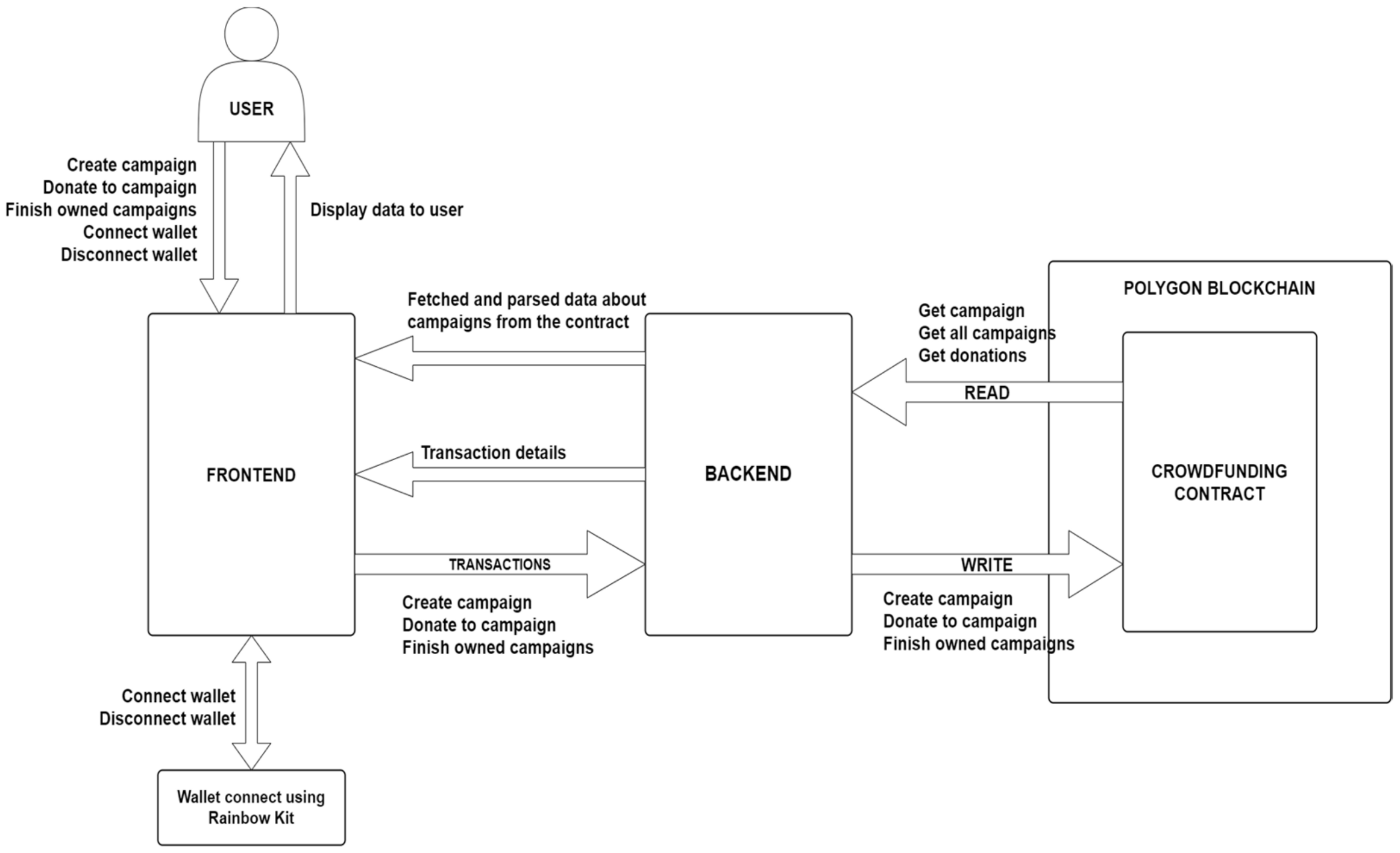

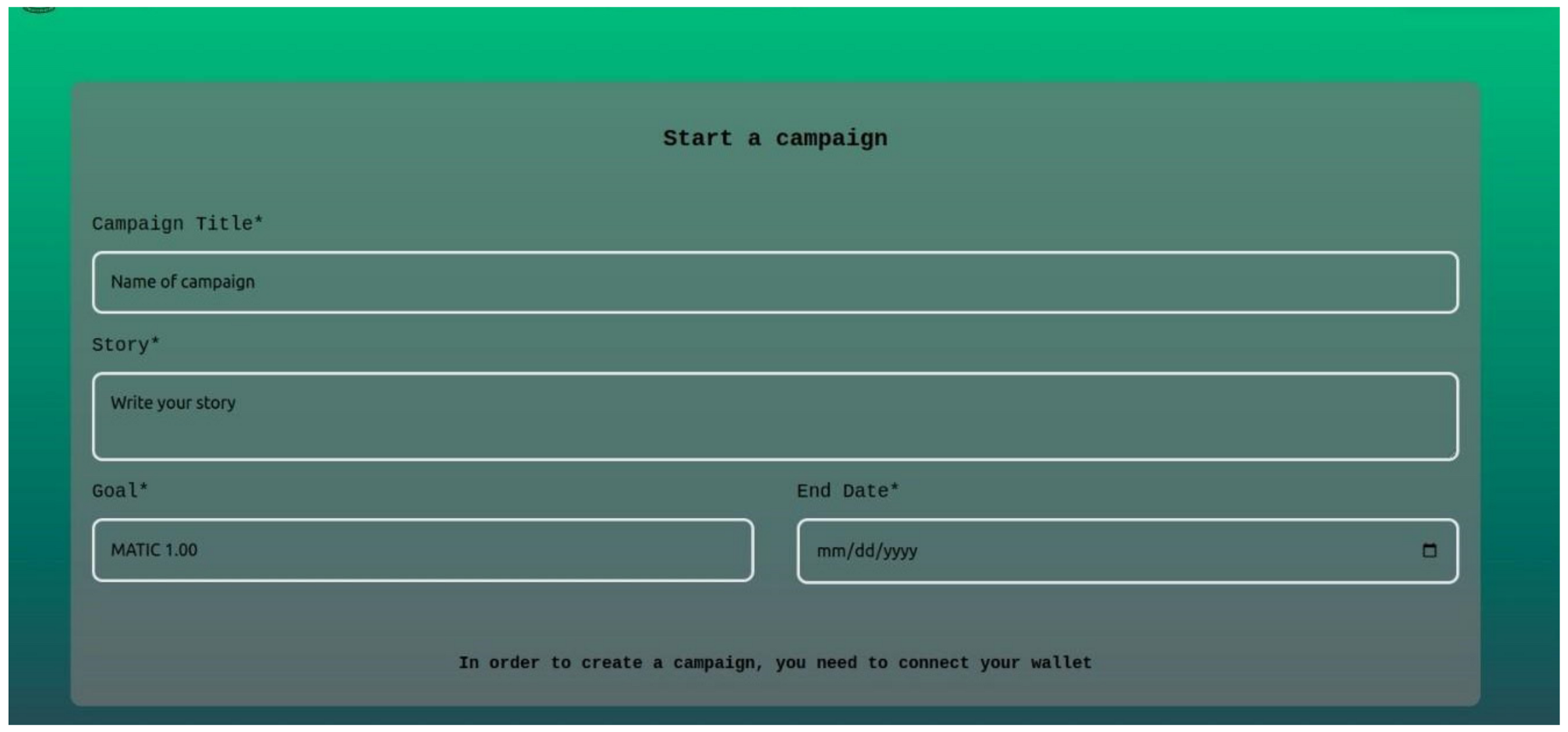

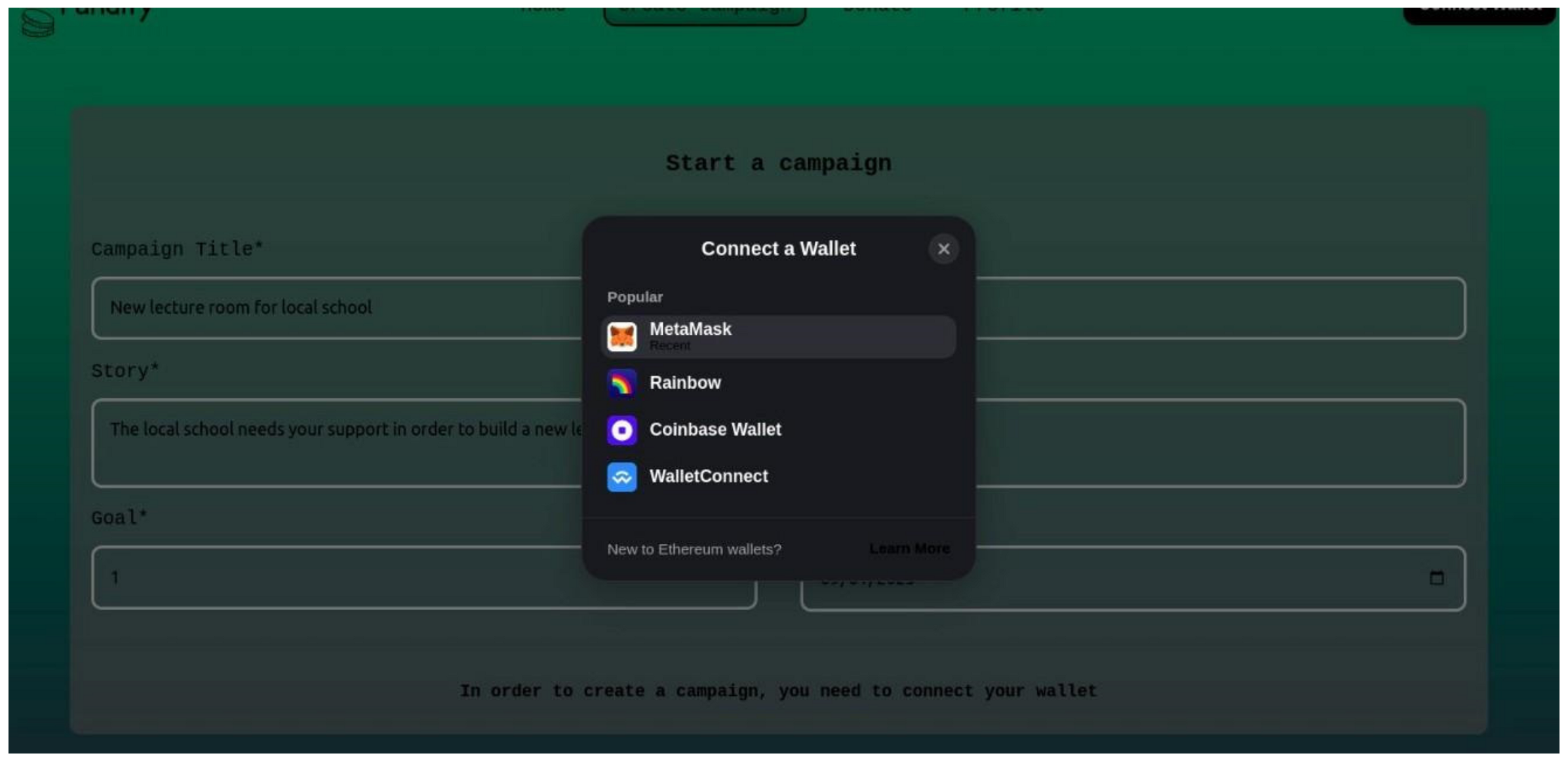
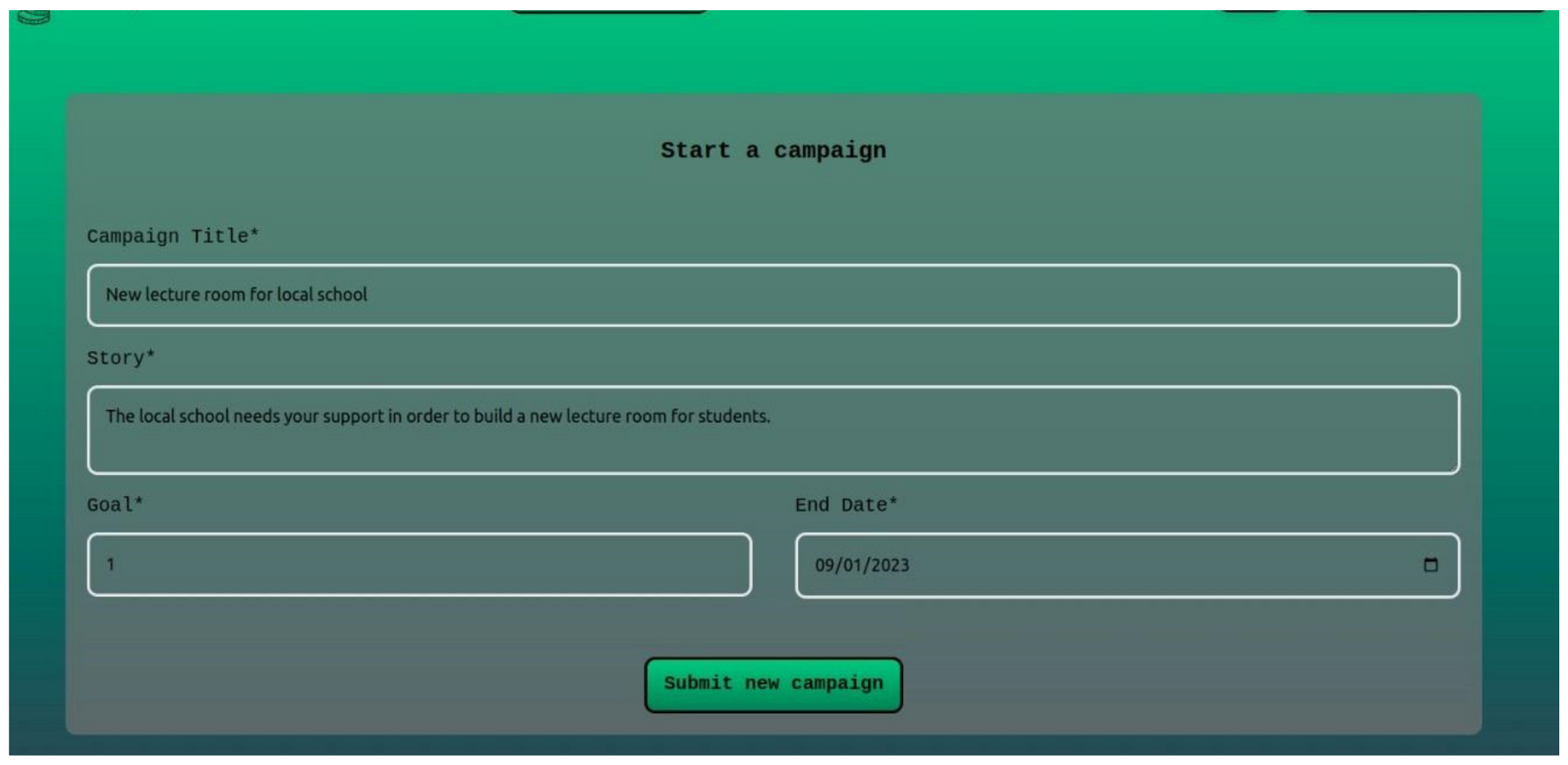
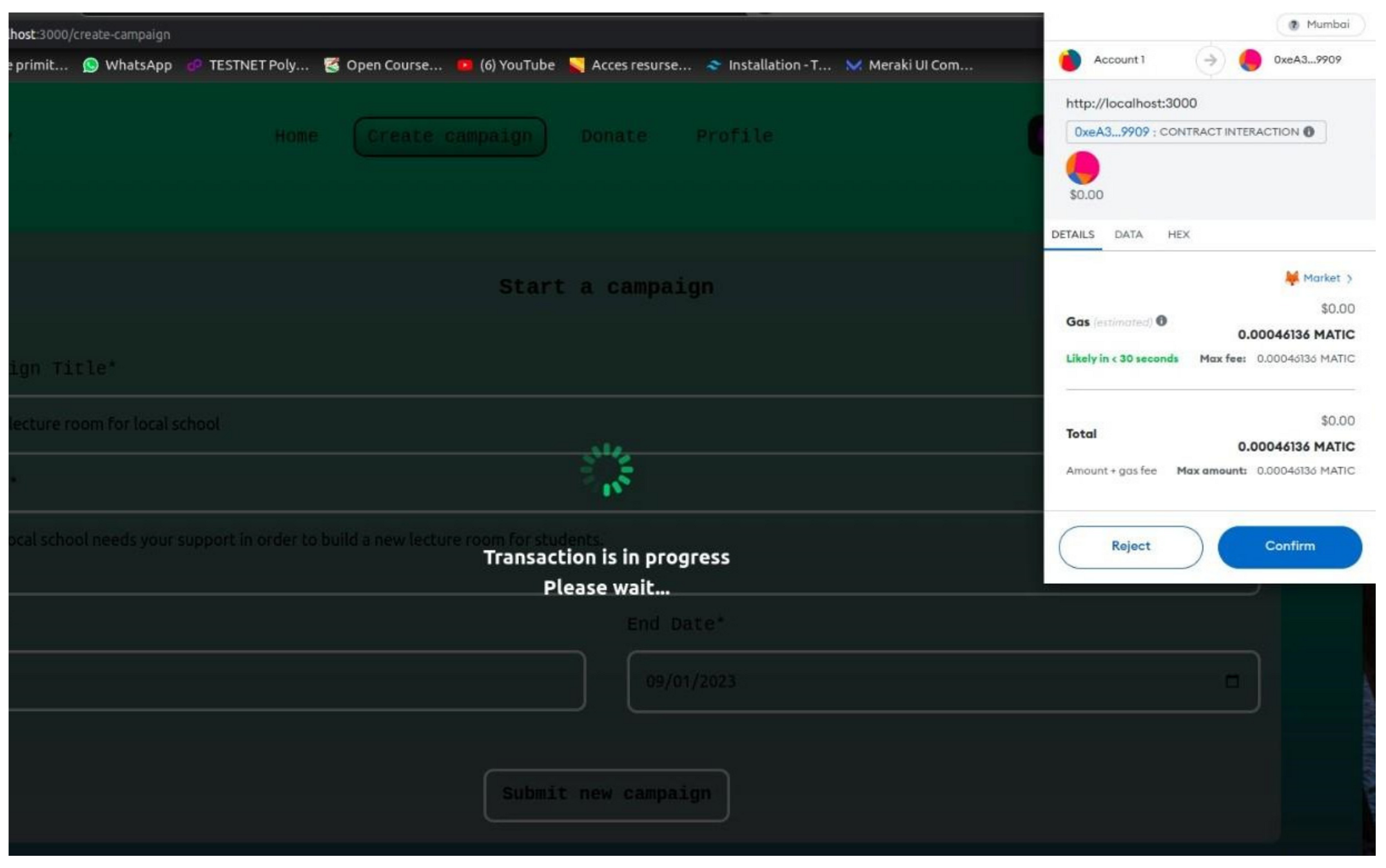
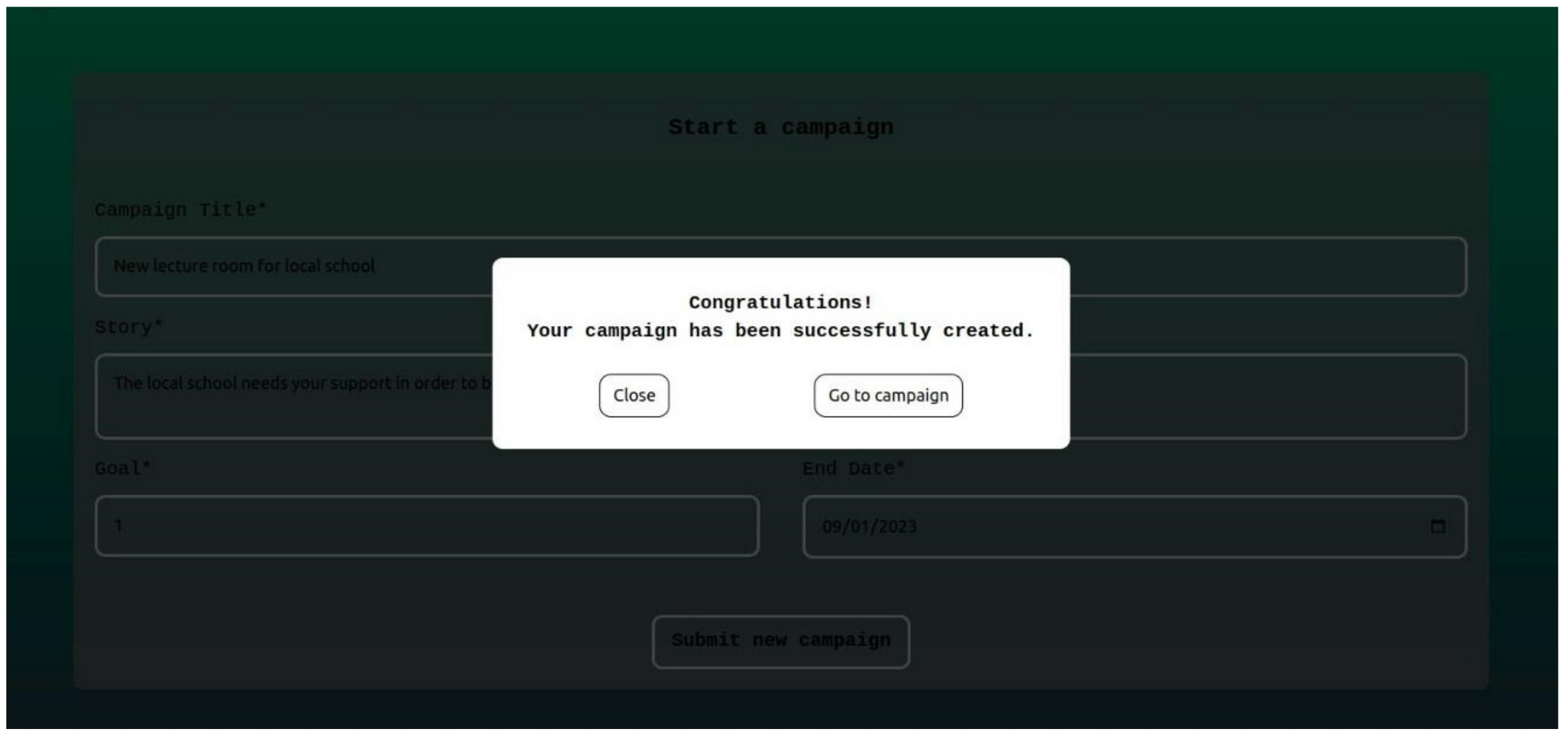





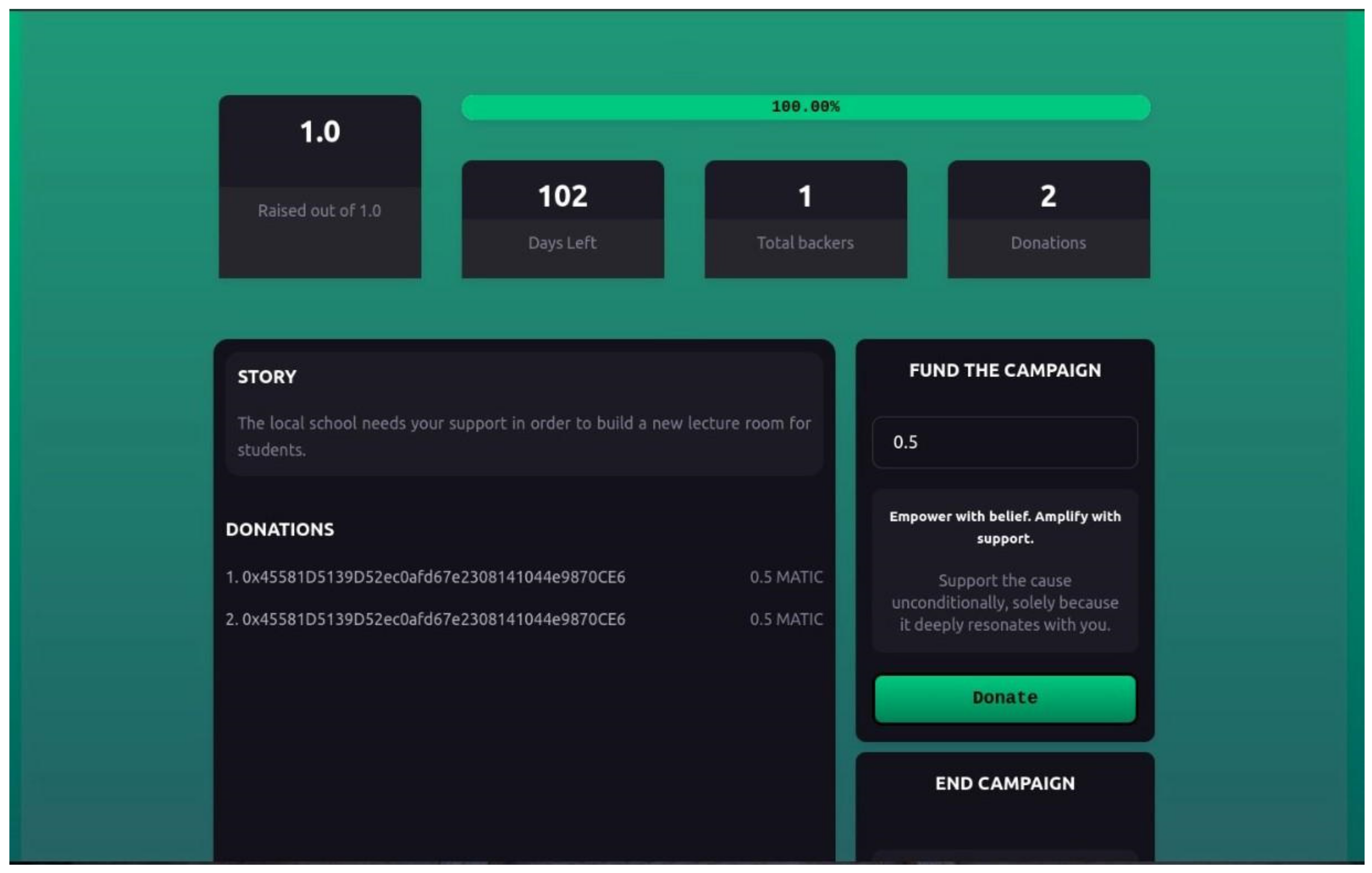

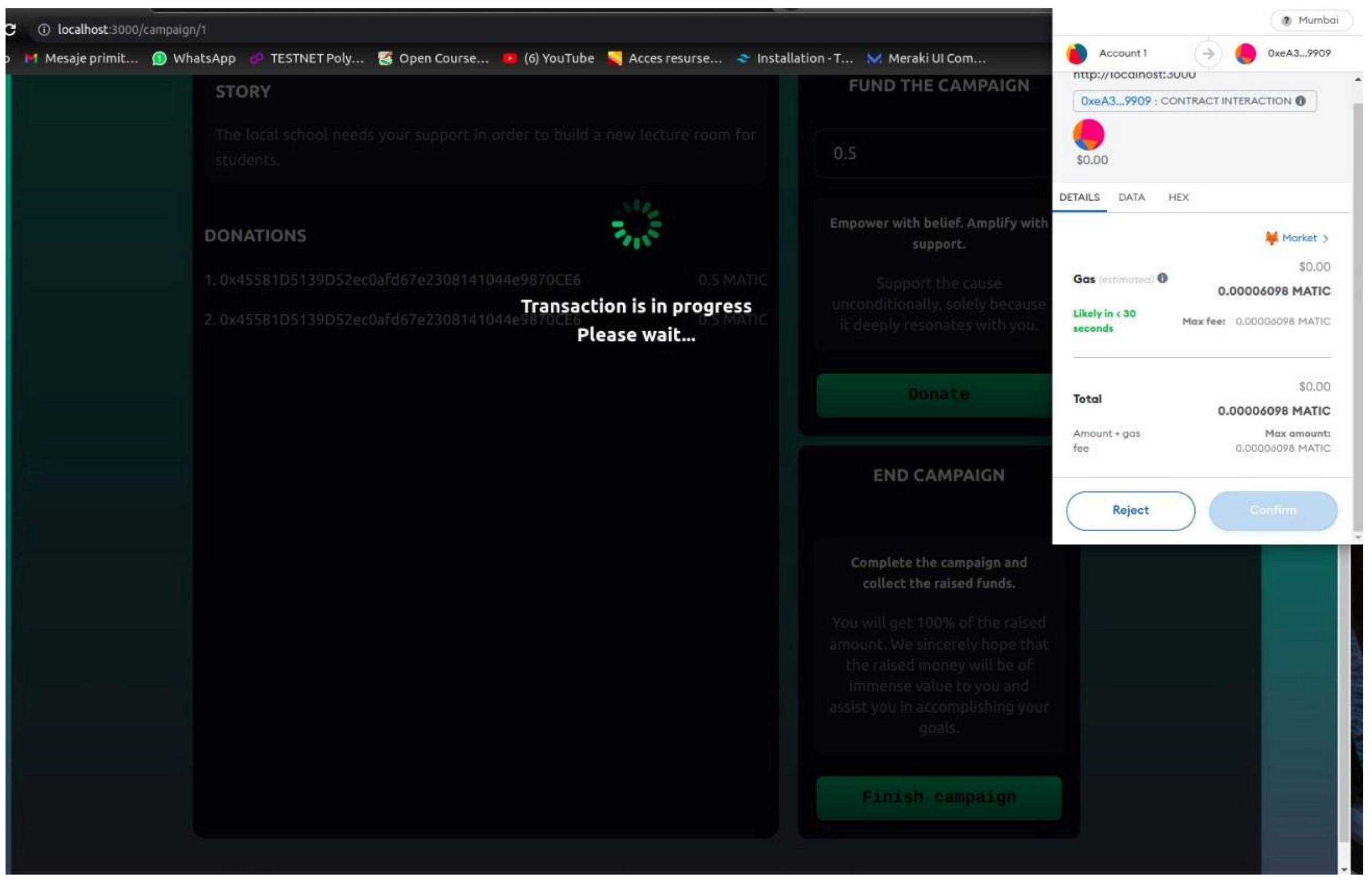



Disclaimer/Publisher’s Note: The statements, opinions and data contained in all publications are solely those of the individual author(s) and contributor(s) and not of MDPI and/or the editor(s). MDPI and/or the editor(s) disclaim responsibility for any injury to people or property resulting from any ideas, methods, instructions or products referred to in the content. |
© 2023 by the authors. Licensee MDPI, Basel, Switzerland. This article is an open access article distributed under the terms and conditions of the Creative Commons Attribution (CC BY) license (https://creativecommons.org/licenses/by/4.0/).
Share and Cite
Tiganoaia, B.; Alexandru, G.-M. Building a Blockchain-Based Decentralized Crowdfunding Platform for Social and Educational Causes in the Context of Sustainable Development. Sustainability 2023, 15, 16205. https://doi.org/10.3390/su152316205
Tiganoaia B, Alexandru G-M. Building a Blockchain-Based Decentralized Crowdfunding Platform for Social and Educational Causes in the Context of Sustainable Development. Sustainability. 2023; 15(23):16205. https://doi.org/10.3390/su152316205
Chicago/Turabian StyleTiganoaia, Bogdan, and George-Madalin Alexandru. 2023. "Building a Blockchain-Based Decentralized Crowdfunding Platform for Social and Educational Causes in the Context of Sustainable Development" Sustainability 15, no. 23: 16205. https://doi.org/10.3390/su152316205
APA StyleTiganoaia, B., & Alexandru, G.-M. (2023). Building a Blockchain-Based Decentralized Crowdfunding Platform for Social and Educational Causes in the Context of Sustainable Development. Sustainability, 15(23), 16205. https://doi.org/10.3390/su152316205


_Lu.png)



